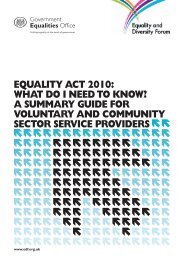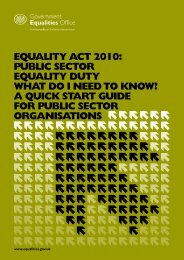A quick start guide to using positive action in recruitment ... - Gov.uk
A quick start guide to using positive action in recruitment ... - Gov.uk
A quick start guide to using positive action in recruitment ... - Gov.uk
Create successful ePaper yourself
Turn your PDF publications into a flip-book with our unique Google optimized e-Paper software.
Positive <strong>action</strong> can be used at any time <strong>in</strong> the<br />
<strong>recruitment</strong> or promotion process.<br />
Example<br />
An accountancy firm is recruit<strong>in</strong>g for its<br />
graduate tra<strong>in</strong><strong>in</strong>g scheme.After the first<br />
round of assessment the firm decides<br />
<strong>to</strong> shortlist 20 candidates.There is a<br />
tie-breaker situation for the 20th place<br />
on the shortlist as there are a number<br />
of candidates of equal merit.The firm<br />
decides <strong>to</strong> use the <strong>positive</strong> <strong>action</strong><br />
provisions <strong>to</strong> advance a candidate from<br />
a BME background <strong>to</strong> the next round of<br />
<strong>recruitment</strong>, because people from BME<br />
backgrounds are under-represented<br />
<strong>in</strong> the firm.This would mean that the<br />
non-BME candidates could not claim<br />
unlawful race discrim<strong>in</strong>ation for not<br />
be<strong>in</strong>g put on the shortlist.<br />
However, it is expected that, <strong>in</strong> the vast majority<br />
of cases, any use of <strong>positive</strong> <strong>action</strong> as a ‘tie-breaker’<br />
between candidates who are of equal merit for a<br />
particular post will be at the end of the <strong>recruitment</strong><br />
process, at the actual po<strong>in</strong>t of appo<strong>in</strong>tment.At that<br />
stage all of the relevant fac<strong>to</strong>rs that the employer<br />
will need <strong>to</strong> know <strong>in</strong> order <strong>to</strong> determ<strong>in</strong>e whether<br />
or not the candidates are truly as qualified as each<br />
other should have been established.<br />
What does ‘equal merit’ mean<br />
In order <strong>to</strong> use <strong>positive</strong> <strong>action</strong> provisions <strong>in</strong> a tiebreaker<br />
situation, the employer must first establish<br />
that the candidates are of equal merit.<br />
Employers should establish a set of criteria aga<strong>in</strong>st<br />
which candidates will be assessed when apply<strong>in</strong>g for<br />
a job.This can take <strong>in</strong><strong>to</strong> account a candidate’s overall<br />
ability, competence and professional experience<br />
<strong>to</strong>gether with any relevant formal or academic<br />
qualifications, as well as any other qualities required<br />
<strong>to</strong> carry out the particular job.<br />
However, employers should ensure that any<br />
criteria do not <strong>in</strong>directly discrim<strong>in</strong>ate aga<strong>in</strong>st<br />
people who share a protected characteristic –<br />
for example, a requirement that staff must work<br />
shift patterns that mean they have <strong>to</strong> be on-call<br />
at certa<strong>in</strong> fixed times might put women, who are<br />
more likely <strong>to</strong> be responsible for childcare issues,<br />
at a disproportionate disadvantage.This would be<br />
unlawful <strong>in</strong>direct discrim<strong>in</strong>ation unless it could be<br />
shown that the need for these work patterns could<br />
be objectively justified.<br />
Employers must consider whether candidates<br />
are of equal merit <strong>in</strong> relation <strong>to</strong> the specific job<br />
or position they are apply<strong>in</strong>g for.While two<br />
candidates may be considered <strong>to</strong> be of equal merit<br />
for one particular post, the same two candidates<br />
might not be equally suitable for another job.<br />
6







